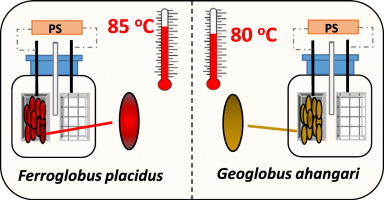Bioelectrochemistry ( IF 4.8 ) Pub Date : 2017-10-02 , DOI: 10.1016/j.bioelechem.2017.09.012 Yasemin D. Yilmazel , Xiuping Zhu , Kyoung-Yeol Kim , Dawn E. Holmes , Bruce E. Logan

|
Few microorganisms have been examined for current generation under thermophilic (40–65 °C) or hyperthermophilic temperatures (≥ 80 °C) in microbial electrochemical systems. Two iron-reducing archaea from the family Archaeoglobaceae, Ferroglobus placidus and Geoglobus ahangari, showed electro-active behavior leading to current generation at hyperthermophilic temperatures in single-chamber microbial electrolysis cells (MECs). A current density (j) of 0.68 ± 0.11 A/m2 was attained in F. placidus MECs at 85 °C, and 0.57 ± 0.10 A/m2 in G. ahangari MECs at 80 °C, with an applied voltage of 0.7 V. Cyclic voltammetry (CV) showed that both strains produced a sigmoidal catalytic wave, with a mid-point potential of − 0.39 V (vs. Ag/AgCl) for F. placidus and − 0.37 V for G. ahangari. The comparison of CVs using spent medium and turnover CVs, coupled with the detection of peaks at the same potentials in both turnover and non-turnover conditions, suggested that mediators were not used for electron transfer and that both archaea produced current through direct contact with the electrode. These two archaeal species, and other hyperthermophilic exoelectrogens, have the potential to broaden the applications of microbial electrochemical technologies for producing biofuels and other bioelectrochemical products under extreme environmental conditions.
中文翻译:

嗜热古细菌Ferroglobus placidus和Geoglobus ahangari在微生物电解池中产生电流
在微生物电化学系统中,很少有人检查过在高温(40–65°C)或超高温(≥80°C)下产生电流的微生物。来自古细菌科的两个还原铁古细菌,铁锈球和钩形线虫,表现出电活性,导致在单室微生物电解池(MEC)中在超高温下产生电流。0.68±0.11 A的电流密度(J)/米2被实现在F.普拉西的MECs在85℃,和0.57±0.10 A /米2在G. ahangariMEC在80°C的条件下,施加0.7 V的电压。循环伏安法(CV)显示,两种菌株均产生S型催化波,中间峰电位为-0.39 V(vs。Ag / AgCl)。G. ahangari为− 0.37 V。使用失效的中位CV和周转CV进行的CV比较,以及在周转和非周转条件下检测相同电势下的峰均表明,不使用介体进行电子转移,并且古细菌都通过直接接触Cv产生电流。电极。这两种古细菌和其他超嗜热性外生电子,有可能拓宽微生物电化学技术在极端环境条件下生产生物燃料和其他生物电化学产品的应用范围。









































 京公网安备 11010802027423号
京公网安备 11010802027423号